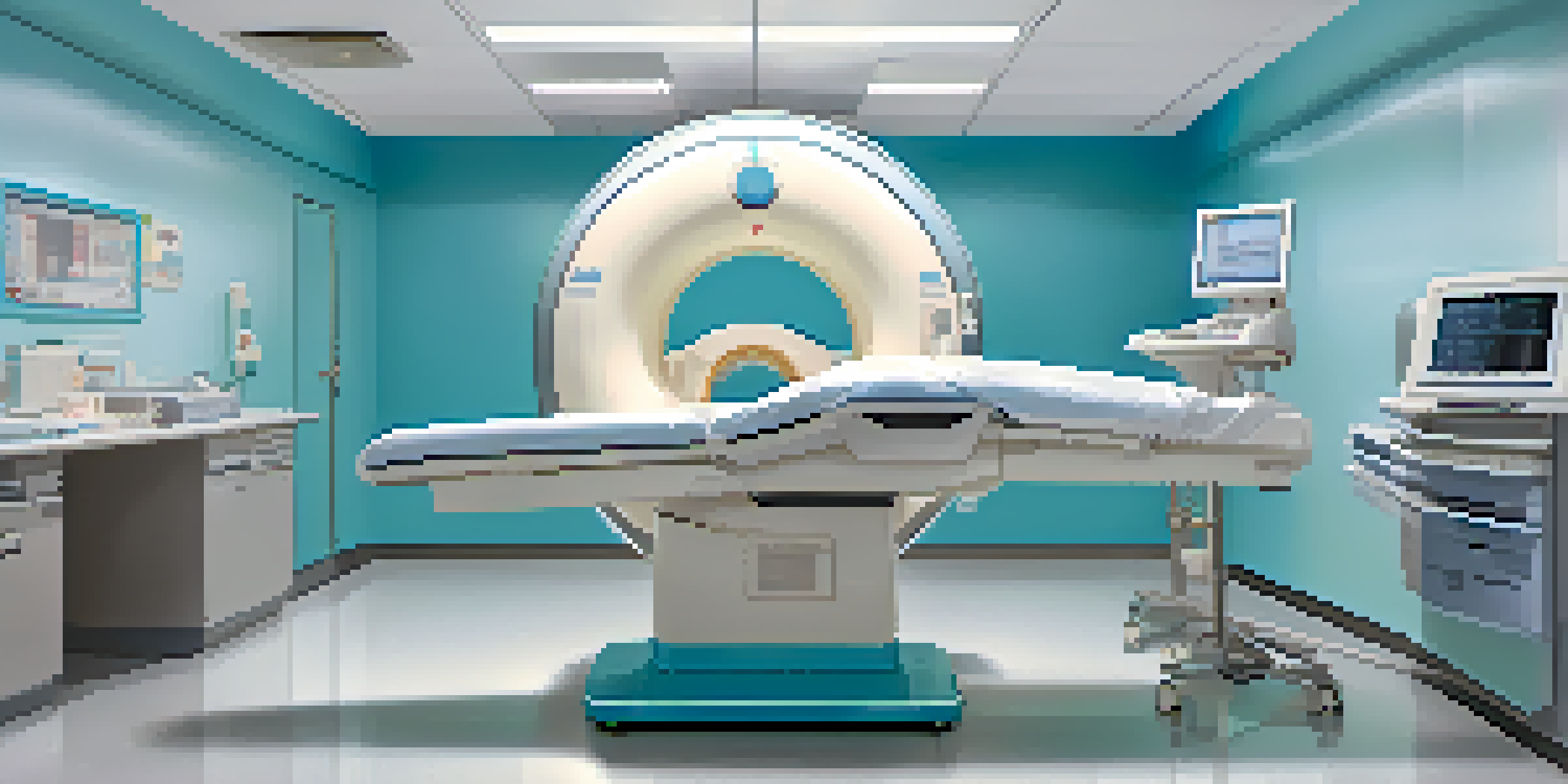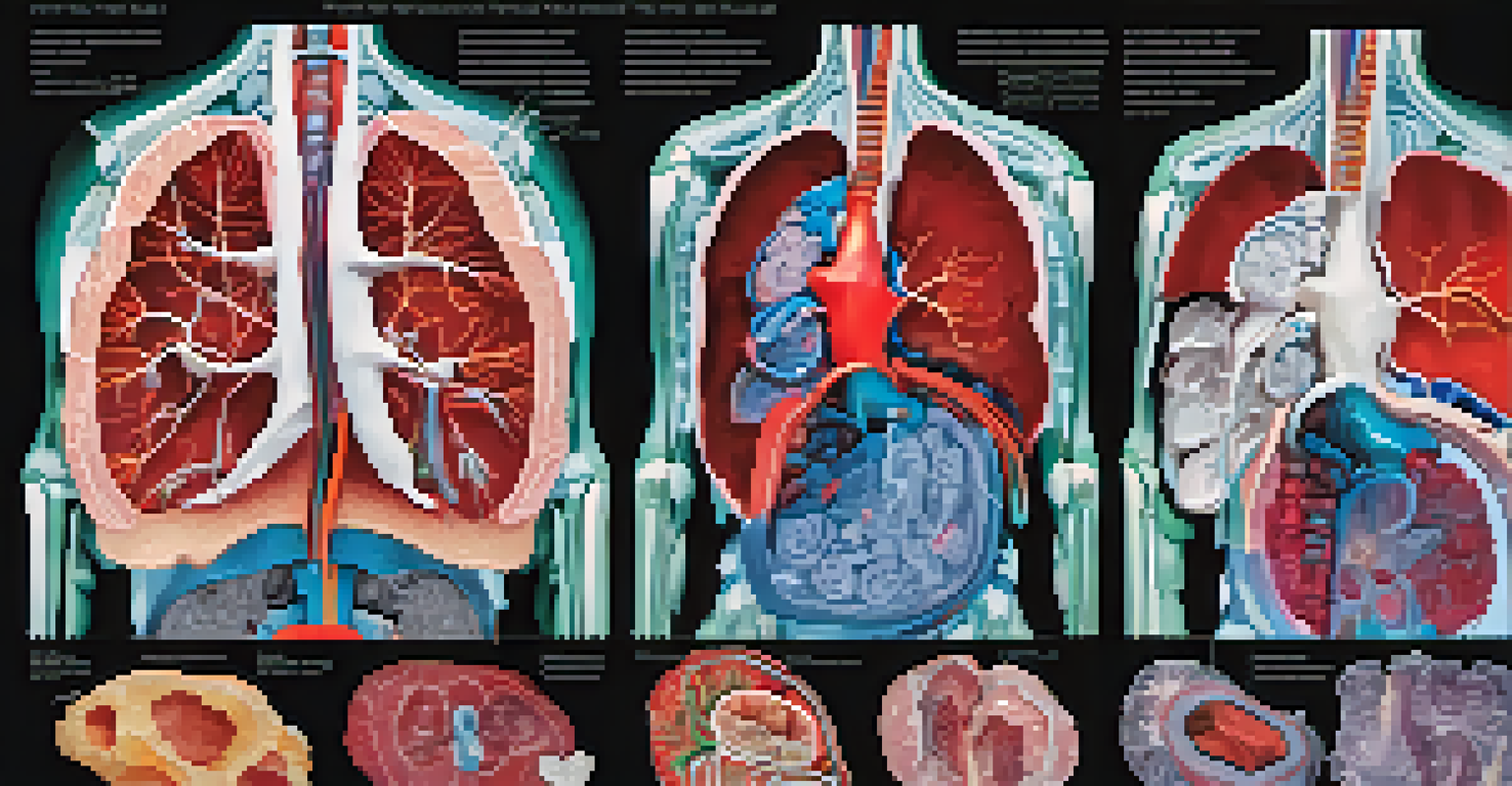CT Scans: A Comprehensive Guide to Computed Tomography

What is a CT Scan and How Does it Work?
A CT scan, or computed tomography scan, is a medical imaging technique that combines X-ray images taken from different angles to create cross-sectional views of the body. This technology provides detailed images of bones, organs, and tissues, allowing doctors to diagnose conditions more accurately. Unlike traditional X-rays, CT scans offer a more comprehensive look, making them invaluable in medicine.
CT scans provide a detailed view of the body's internal structures, making them invaluable in diagnosing complex medical conditions.
During the procedure, a patient lies on a table that slides into the CT machine, which resembles a large doughnut. The scanner takes rapid images as it rotates around the body, and a computer processes these images to construct detailed slices of the area being examined. This technology is particularly useful for detecting tumors, internal bleeding, and other abnormalities.
CT scans are performed in hospitals and radiology centers, and they usually take no more than 30 minutes, depending on the area being studied. Patients may be asked to hold their breath for short periods to ensure clear images, but the process is generally quick and painless.
The Benefits of CT Scans in Diagnosis
CT scans offer several advantages when it comes to diagnosing medical conditions. One of the significant benefits is their ability to provide detailed images of internal structures, which help doctors identify problems that may not be visible with other imaging techniques. This level of detail is crucial for conditions like cancer, where precise location and size of tumors are vital for treatment planning.

Another benefit is the speed at which a CT scan can be performed and analyzed. In emergency situations, such as trauma cases, a CT scan can quickly help identify life-threatening injuries, allowing for prompt intervention. Additionally, advancements in technology have made CT scans faster and more efficient, reducing the time patients spend in the scanner.
CT Scans: Advanced Imaging Tool
CT scans combine multiple X-ray images to provide detailed cross-sectional views of the body, aiding in accurate diagnoses.
Moreover, CT scans are non-invasive, which means they can be performed without making any incisions, minimizing risk and discomfort for patients. This accessibility has made CT scans an essential tool in modern medicine, frequently used in routine check-ups and emergency evaluations alike.
Common Uses of CT Scans in Medicine
CT scans are versatile and can be used to investigate a wide range of medical conditions. Some common applications include assessing injuries from accidents, evaluating cancer stages, and diagnosing infections. This versatility makes CT scans a go-to imaging method for many healthcare professionals.
The advancements in CT technology not only enhance image quality but also prioritize patient safety by reducing radiation exposure.
For instance, in cases of suspected appendicitis, a CT scan can quickly confirm the diagnosis, allowing for timely surgical intervention. Similarly, they are often used to monitor the effectiveness of treatments for conditions like cancer, providing crucial information on tumor response over time. This ongoing evaluation helps doctors adjust treatment plans as necessary.
In addition to these uses, CT scans are also valuable in surgical planning. Surgeons can use detailed images to visualize complex anatomy before performing procedures, improving outcomes and reducing risks during surgery. This preoperative imaging has transformed how many surgeries are conducted, leading to safer and more efficient operations.
Preparing for Your CT Scan: What to Expect
Preparation for a CT scan is typically straightforward, but it can vary depending on the type of scan being performed. Patients are often advised to wear loose-fitting clothing and may be asked to remove any metal objects, such as jewelry, that could interfere with the imaging. In some cases, fasting for a few hours before the scan is recommended, especially when contrast material is used.
If contrast dye is needed for the scan, patients might receive it orally or through an injection. This dye helps highlight specific areas in the body, providing clearer images. It's important to inform the healthcare provider of any allergies, especially to iodine, as this can affect the use of contrast material.
Benefits in Emergency Situations
Their speed and non-invasive nature make CT scans essential for quickly identifying life-threatening conditions in emergencies.
Once you arrive for your appointment, a radiologic technologist will guide you through the process, explaining each step to ensure you feel comfortable. After the scan, patients can typically resume normal activities immediately, making the entire experience as seamless as possible.
Risks and Considerations of CT Scans
While CT scans are generally safe, they do involve exposure to ionizing radiation, which can raise concerns, especially with frequent use. However, the amount of radiation received during a CT scan is relatively low, and the diagnostic benefits often outweigh the risks. Healthcare providers carefully consider the need for a scan in light of a patient's medical history and symptoms.
It's also important to discuss any previous imaging tests with your doctor, as multiple scans over time can accumulate radiation exposure. For patients with certain conditions, such as pregnancy, alternative imaging methods like ultrasound or MRI may be recommended to avoid potential risks to the fetus.
Ultimately, the decision to proceed with a CT scan is made collaboratively between the patient and healthcare provider, taking into account the potential benefits and risks. This open dialogue ensures patients are well-informed and comfortable with their care decisions.
Understanding CT Scan Results: What They Mean
After a CT scan, the images are reviewed by a radiologist, who will interpret the results and provide a report to the referring physician. This report includes findings related to any abnormalities detected, which helps guide further treatment or evaluation. Understanding what these results mean can be crucial for patients navigating their health conditions.
It's common for patients to feel anxious while waiting for results, but it's important to remember that a normal scan is often a good sign. If abnormalities are found, the doctor will discuss the next steps, which may include additional tests or referrals to specialists for further evaluation. This proactive approach ensures that any issues are addressed promptly.
Future Innovations in CT Technology
Ongoing advancements, including AI integration and improved imaging techniques, promise to enhance the safety and effectiveness of CT scans.
Patients are encouraged to ask questions about their results and what they imply for their health. Clear communication between patients and healthcare providers is essential for making informed decisions about further care and management.
The Future of CT Scans: Innovations on the Horizon
The field of medical imaging is continually evolving, and CT scans are benefiting from innovative advancements. One exciting development is the introduction of advanced imaging technologies that enhance image quality while reducing radiation exposure. Techniques like iterative reconstruction and dual-energy CT are making scans safer and more effective.
Moreover, artificial intelligence is beginning to play a role in analyzing CT scan images, helping radiologists detect abnormalities more efficiently. This technology can assist in identifying subtle changes that may be missed by the human eye, leading to earlier diagnosis and improved patient outcomes.

As technology continues to advance, we can expect CT scans to become even more precise and accessible. With ongoing research and innovation, the future looks promising for this essential diagnostic tool, ultimately improving patient care and health management.